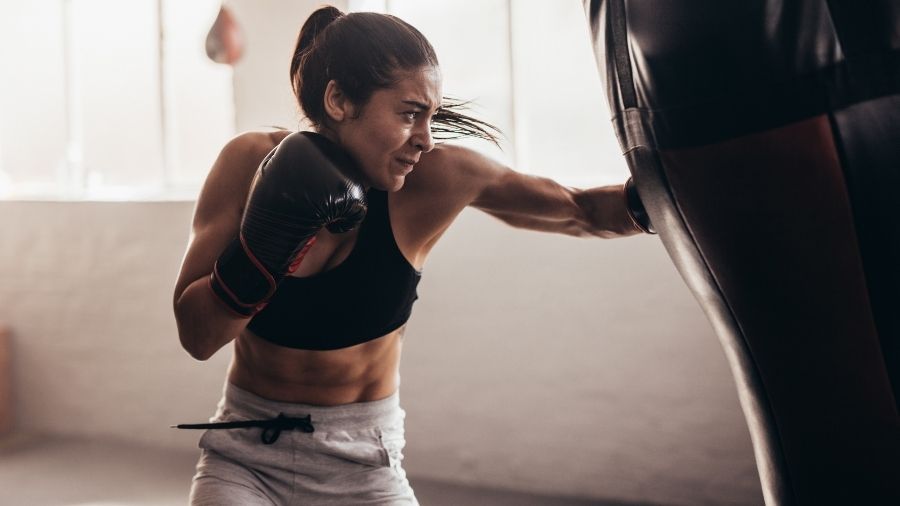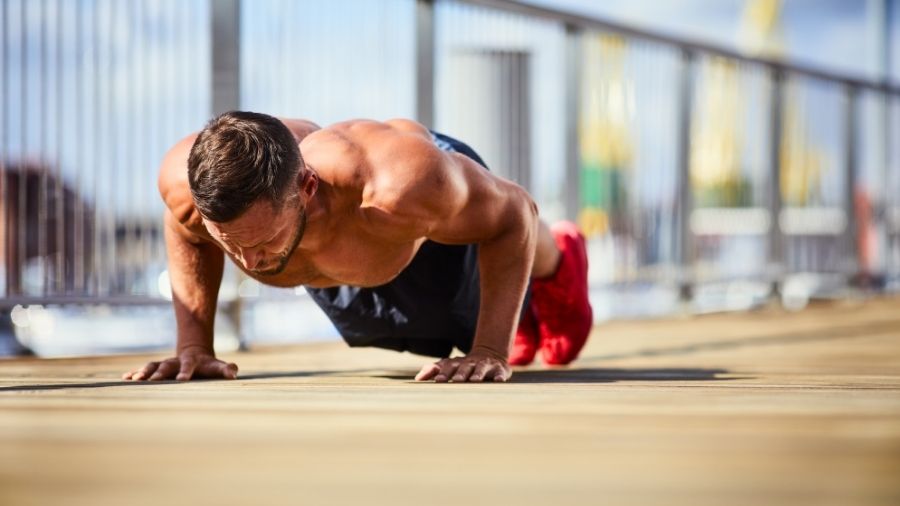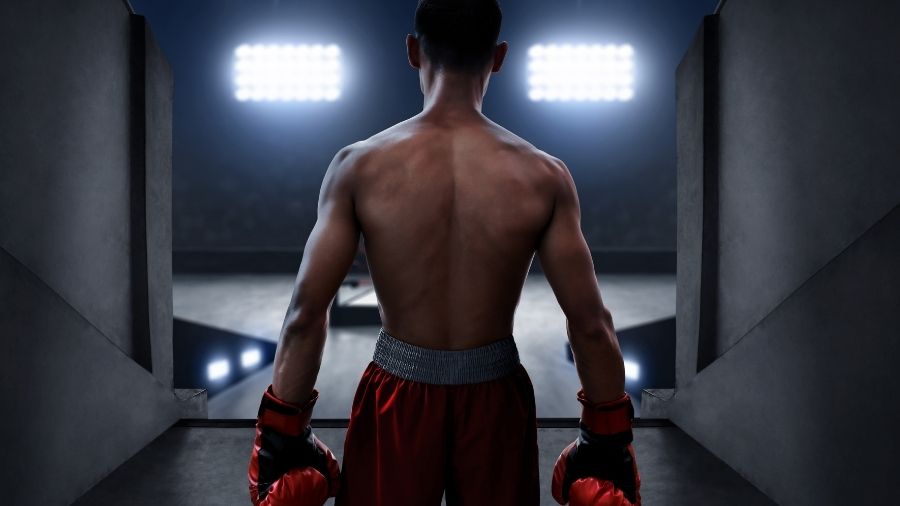Some boxers have huge muscular physiques. Think of Mike Tyson in his day. An intimidating muscle-bound boxer. But was it purely boxing that built those muscles?
Boxing does not build muscle as there is no resistance which means it doesn’t stimulate the key mechanisms of building muscle which is mechanical tension and metabolic stress.
Before diving deeper into why boxing doesn’t build muscle and how you can build muscle, let’s take a look at the muscles boxing works.
What Muscles Are Worked When Boxing?
While it may not look it at face value, boxing is a full-body workout. It’s not just your upper body when throwing punches. The legs are the greatest contributor to punching power in the most experienced boxers [1].
Calves
Not only do the calves help initiate the power for the punch from the floor, but they are also heavily involved in moving around the ring. Those boxers that are light on their feet have high levels of calf endurance which can be developed through boxing and jumping rope.
Discover The Little Known Secrets For Unlocking Devastating KO Power!
Heavy hands are built doing these things...
Hips And Legs
The calves are small muscles compared to the muscles of the thighs and hips. This is where serious punching power comes from when sitting on punches and pivoting the hips. Strong hips and legs also allow you to pivot and move around the ring quickly.
Core
I don’t like the term core as the core encompasses more than just the abs. The core covers everything from the shoulders down to the hips. So instead, I will talk about the trunk which consists of the abs and lower.
The trunk is vitally important for rotational power when punching and transferring force developed from the legs to the hands. Being able to stiffen the trunk muscles at impact is an important aspect of punching hard as it enhances effective mass [2]. Meaning more force is able to be imparted to the target (your opponent).
Back
It may surprise you that boxing requires the muscles of the back to pull back punches quickly and provide a stable base to throw punches from.
Shoulders
As you may know from experience, your shoulders can take a hammering. Holding your hands up in your guard and throwing punches will leave your shoulders burning if you are not accustomed to it.
Arms
Just like the shoulders, the muscles of your arms will take a beating. From making a fist when punching and extending and retracting your arm, you will feel them working hard.
Does Boxing Build Muscle?

Now you see that boxing is a full-body exercise, you may draw the conclusion that boxing builds muscle all over the body. However, this is not correct. Boxing does not build muscle. It doesn’t matter if you are shadowboxing or hitting the heavy bag, boxing does not stimulate the key mechanisms of muscle growth.
That is mechanical tension and metabolic stress [3]. Maximizing mechanical tension is about having the muscle produce high forces (by lifting heavy loads) through a full range of motion (going from a contracted to a fully stretched position.
But mechanical tension can also be increased with lighter loads when taken to failure or close to failure. As the speed of the exercise slows down (think of that last grueling rep of a bench press set), you are creating more tension within the muscle.
Metabolic stress is the build-up of nasty by-products from energy production [4]. These by-products are what you would associate with the “burning” feeling when you are performing high rep exercises.
Boxing does not provide adequate muscular tension or metabolic stress to stimulate the building of muscle. There is no external resistance or resistance to overcome and boxing doesn’t require a high force production because of that.
Does Boxing Build Back Muscle?
The only actions in boxing are in front of the body. There are no horizontal or pulling movements with any load. Therefore, boxing will not build back muscle. Being in the clinch may be considered use of the back muscles but there is a lack of time in these positions, it’s often passive, and the clinch is mainly isometric and at short muscle lengths.
Does Boxing Build Leg Muscle?
Boxing does not build leg muscle. Knee and hip flexion are minimal within the boxing stance. That means the muscles of the legs barely go through any range of motion which is important for maximizing mechanical tension and metabolic stress.
Does Boxing Build Arm Muscle?
Boxing does not build arm muscle even though the sport highly involves the muscle of the arm. Boxing does not require any external resistance and therefore, there is no load placed on the muscles.
How Do Boxers Build Muscle Without Lifting Weights?

You may be wondering how many boxers have muscular physiques if boxing itself does not build muscle? Many boxers supplement their training with weight training. Strength training is a key part of boxing training to not only improve force and power output but to keep you healthy.
But some boxers don’t hit the gym either. Many boxers will perform calisthenics or bodyweight exercises as part of their boxing training. This will involve various push-ups, pull-ups, bodyweight squats, and ab exercises.
Done in high enough volume and close to failure, these exercises can build muscle mass. Here is how it could look.
Boxing Workout For Building Muscle
Warm-Up
- Shadowboxing x 5-10 min
- Jump rope x 5-10 min
Workout
A1) Push-Ups 3-4 x 20-30
A2) Pull-Ups 3-4 x 5-10
B1) Bodyweight Squat or Single Leg Squat 3-4 x 50 or 3-4 x 10-20/leg
C1) V-Ups 3 x 15
C2) Russian Twist 3 x 20
C3) Hanging Leg Raise 3 x 10
Do You Want Big Muscles As A Boxer?
Having big muscles is not something you’d want as a boxer. Having more muscle mass requires more oxygen and carbohydrates to fuel when exercising. The result? You’ll gas out faster. That doesn’t mean you do no weight training.
Strength training can be performed in a way that doesn’t promote muscle growth. Strength Train Like A Professional Boxer does just this.
However, adding some muscle mass if you are skinny can be beneficial helping to increase your potential to produce force and punch harder. Further, if you are looking to move up a weight class, it’s important that you add muscle mass and not fat mass as being overly fat will make boxing much harder especially if you are used to boxing at lighter bodyweights.
What Does Boxing Do For Your Body?

Even though boxing does not build muscle, it can do amazing things for your body. It is an excitingly fun activity and sport that will hook you to train multiple times a week. Being this active only has its benefits. You’ll start to shed pounds if you haven’t been as active before turning you into a lean machine.
You’ll gain immense confidence in being able to handle yourself in any situation. Increased confidence will change your posture for the better and you’ll be standing tall with your shoulders back without even noticing.
Is Boxing Good For Muscle Growth?
While boxing is a great form of exercise, boxing is not going to build slabs of muscle anywhere on your body. If you want to add muscle mass, you need to hit the gym with a strength training routine designed to add muscle mass. However, if boxing is your number one goal, then I would advise you to avoid adding a lot of muscle mass.
References
1. Filimonov VI, K.K., Husyanov ZM, & Nazarov SS., Means of increasing strength of the punch. NSCA Journal, 1985. 7: p. 65-66.
2. Lenetsky, S., Nates, R, Brughelli, M, Harris, N., Is effective mass in combat sports punching above its weight? Human Movement Science, 2015. 40: p. 89-97.3
3. Schoenfeld, B. J. (2010). The mechanisms of muscle hypertrophy and their application to resistance training. The Journal of Strength & Conditioning Research, 24(10), 2857-2872.
4. Schoenfeld, B. J. (2013). Potential mechanisms for a role of metabolic stress in hypertrophic adaptations to resistance training. Sports medicine, 43(3), 179-194.

